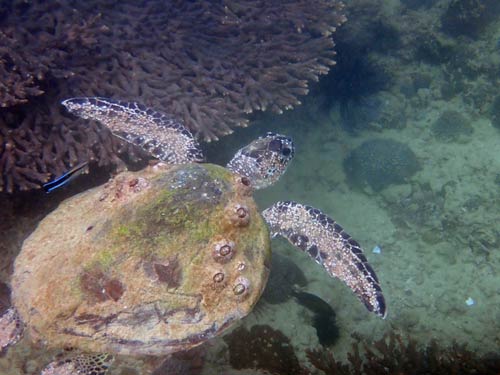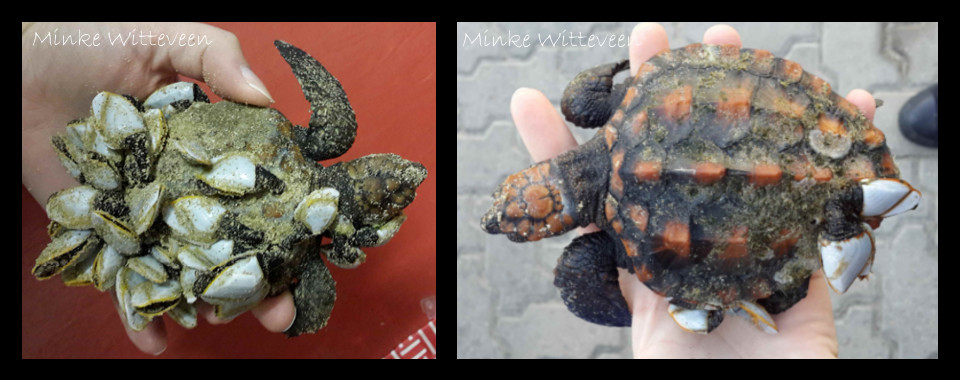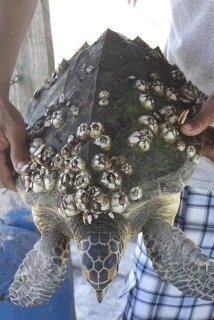Barnacles attach to turtles to gain access to food and protection from predators. They form a symbiotic relationship.
Barnacles are small marine crustaceans that attach themselves to various surfaces, including sea turtles. By attaching to the turtle’s shell, barnacles benefit from a constant source of food as they filter feed on particles in the water. In return, the barnacles provide camouflage and protection for the turtle, helping them blend in with their surroundings and avoid predators.
This mutually beneficial relationship allows both species to thrive in their ocean ecosystem. Understanding why barnacles attach to turtles sheds light on the intricate connections and adaptations that exist in the natural world.
The Barnacle-turtle Relationship
Barnacles are fascinating marine organisms that have a unique relationship with turtles. These crustaceans attach themselves to the shells of turtles, forming a symbiotic bond that benefits both parties.
What Are Barnacles?
Barnacles are small, hard-shelled crustaceans that belong to the class Cirripedia. They are stationary marine animals that attach themselves to hard surfaces such as rocks, ships, and in this case, turtles.
Types Of Barnacles
- Acorn Barnacles: These barnacles have a cone-shaped shell and are commonly found in intertidal areas.
- Goose Barnacles: These barnacles have a flexible stalk and are often found attached to floating objects.
- Stalked Barnacles: These barnacles have a long stalk that attaches them to surfaces such as rocks.
The barnacle-turtle relationship is a unique example of symbiosis in the marine ecosystem. Through this mutualistic association, barnacles benefit from a mobile substrate for feeding and reproduction, while turtles may experience increased drag due to the additional weight of the barnacles.

Credit: oliveridleyproject.org
Barnacle-turtle Interaction
When it comes to the interaction between barnacles and turtles, it’s a fascinating example of symbiosis in nature. Barnacles are crustaceans that attach themselves to the shells of sea turtles, creating a unique relationship that has both positive and negative impacts on the turtles.
How Barnacles Attach To Turtles
Barnacles attach to turtles through a process called cementation, where they secrete a sticky substance to firmly adhere to the turtle’s shell. Their larval stage involves free-swimming in the ocean until they find a suitable host, such as a turtle, to settle on and begin their sedentary lifestyle.
Impact On Turtle Health
The presence of barnacles on a turtle’s shell can create drag, making it more difficult for the turtle to swim efficiently. Additionally, the weight of the barnacles may affect the turtle’s buoyancy, potentially impacting its ability to dive and surface for air. However, barnacles can also provide camouflage and protection against predators for the turtles.
Reasons For Attachment
Barnacles attach to turtles for several reasons, including protection from predators and transportation to new feeding grounds. The barnacles also benefit from the turtle’s movement, which creates a constant flow of water and nutrients.
Barnacles are known to attach themselves to different marine animals, including turtles. But have you ever wondered why? There are various reasons why barnacles attach to turtles. In this section, we will discuss two main reasons: protection for barnacles and benefits for turtles.Protection For Barnacles
Barnacles are immobile creatures that need a stable surface to attach themselves to. Turtles provide this stability, as they move through the ocean. The turtle’s shell acts as a perfect surface for barnacles to attach themselves to. The barnacles attach themselves to the turtle’s shell using a cement-like substance that hardens once it dries. By attaching themselves to turtles, barnacles can avoid being swept away by strong ocean currents and avoid being eaten by predators.Benefits For Turtles
While barnacles may seem like a burden for turtles, there are actually benefits to having them attached to their shells. Firstly, barnacles can act as a form of camouflage, making it harder for predators to spot the turtle. Secondly, barnacles can provide an additional food source for the turtle. As turtles swim through the ocean, they may accidentally ingest barnacles attached to their shells. This provides the turtle with additional nutrients, which can be especially beneficial for younger turtles that are still growing. In conclusion, the attachment of barnacles to turtles is a symbiotic relationship. Barnacles provide a stable surface for attachment and protection, while turtles receive a form of camouflage and additional nutrients.Adaptations And Evolution
Barnacles attaching to turtles is a fascinating example of co-evolution and the adaptations that have occurred over millions of years. Understanding the evolutionary history and the specific adaptations that barnacles have developed to attach to turtles provides insight into the intricate relationships between species in the natural world.
Evolutionary History
The evolutionary history of barnacles attaching to turtles dates back to ancient times, with evidence suggesting that this symbiotic relationship has been in existence for millions of years. As turtles move through the ocean, they provide a unique substrate for barnacles to attach to, offering them a means of transportation and access to food sources. Over time, this relationship has evolved, with both barnacles and turtles developing specific adaptations to enhance the success of their association.
Adaptations For Attachment
Barnacles have evolved specialized appendages, known as cirri, that allow them to firmly attach to the shell or skin of turtles. These appendages are well-suited for gripping onto the irregular surfaces of turtles, providing a secure hold that withstands the forces of ocean currents and the turtle’s movements. Additionally, the shape and structure of barnacle shells have been optimized for attachment, enabling them to endure the challenges of life in the open ocean.
Ecological Significance
Understanding the ecological significance of barnacles attaching to turtles is crucial in comprehending their role in marine ecosystems. These interactions between barnacles and turtles have far-reaching implications for the balance and health of marine environments.
Role In Marine Ecosystems
The attachment of barnacles to turtles plays a vital role in marine ecosystems. Barnacles are filter feeders, and their presence on turtles provides them with a mobile substrate for feeding and reproduction. This relationship creates a unique ecosystem within the turtle’s shell, promoting biodiversity and serving as a habitat for various organisms.
Conservation Implications
The presence of barnacles on turtles has important conservation implications. Turtles act as hosts for barnacles, and the presence of barnacles can affect the turtle’s hydrodynamics, energy expenditure, and overall health. Understanding this relationship is essential for the conservation and management of turtle populations, as it highlights the interconnectedness of species within marine ecosystems.

Credit: oceanadventures.co.za

Credit: www.the-scientist.com
Conclusion
In nature, barnacles attach to turtles for protection and transportation, forming a unique symbiotic relationship. Understanding this fascinating phenomenon sheds light on the interconnectedness of marine ecosystems. By studying these interactions, we can gain valuable insights into the delicate balance of life underwater.
Explore more to uncover nature’s wonders.






Leave a Reply